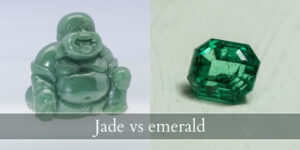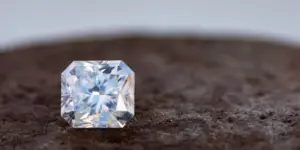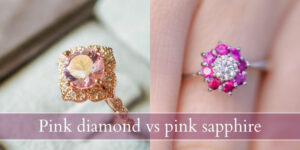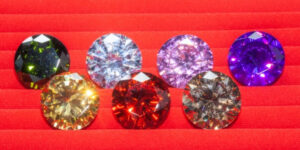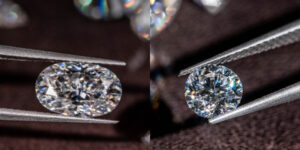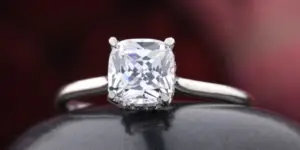Ovals and per cuts are beautiful diamonds that slim the finger and give the hand an elegant, slender look. But, not everyone can wear a pear and not all ovals are a great choice. The point on a pear cut might be what draws you in and also what makes you look for a different stone, and the symmetry of an oval can be both reassuring and a bit bland.
This is why we’ll be going through the differences between pear and oval cuts, so you have have a better idea of which diamond cut you’d like better. Of course, you should still go out and try a few pears and ovals of similar carat sizes. It’s one thing to read, and another to see the diamonds up close and wear them. You might be surprised what you decide on ! For now let’s discuss the two.
Oval vs pear diamond cut
Oval cuts are more popular than pear cuts because they are a timeless classic while pears tend to fall in and out of fashion. Pear cuts show more crushed ice in the top half, while oval cuts offer a symmetrical sparkle on both ends. Because of the way a pear’s point is cut, pears face up larger than oval cuts of the same carat size./ Pear also tend to be more affordable than oval cuts, simply because they’re not as in demand as ovals.
Both pear and oval cuts are great at hiding inclusions so you could go as low as SI1 with these. For pears you might want to make sure the inclusions (if any) are white or at least grey if they’re on the point. Both hide color fairly well so anything H and up will show up alright.
Read also: Lab Grown VS Natural Diamonds
What is an oval cut ?
Oval cut diamonds look like elongated round cut brilliants, and for the most part that is what they are. Oval cuts are a brilliant cut, so they have a lot of fire and brilliance, but they have an elongated shape that proves flattering to most people. These cuts are also symmetrical meaning they are a bit of a classic, you can’t go wrong with them, and they seem to match everything.
There are many variations on the oval cut, mainly in the length/width ratio. You can get short and stubby ovals, long skinny ones, and ones that almost turn into a marquise (with very narrow ends). Which kind of oval you like will depend on which looks better on your hand, and in the ring design you like best. For example a very skinny oval leaves plenty of room for some intricate side stone work.
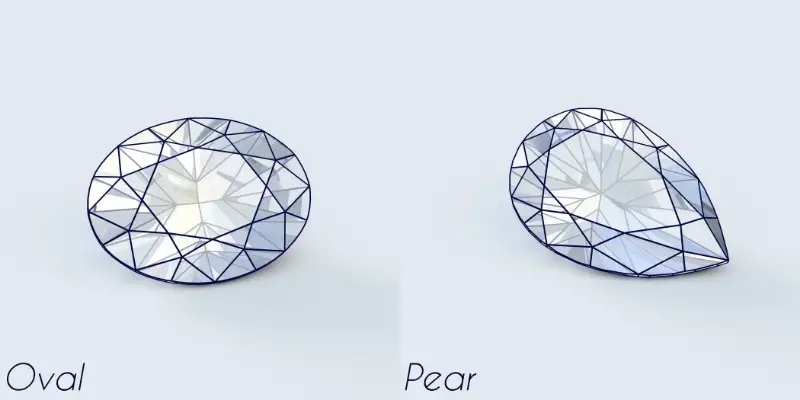
What is a pear cut ?
A pear cut is a brilliant diamond cut with a rounded bottom and pointed top, like a teardrop shape or a pear with a sharp top. This shape has been around for centuries and is viewed as an antique or vintage cut, just like the marquise cut.
Pear cuts, like oval cuts, make the finger appear slender and elegant, but they are much harder to style or wear successfully due to their pointed top (again, similar to the marquise). These cuts are also a bit fragile precisely due top their sharp point and we will get into that in a minute.
The pear cut has a lot of variation to it in terms of length/width ratio and finding the right one may prove even more difficult because of this. Now let’s compare the oval cut to the pear cut.
1. Ovals are safer cuts, pear cuts need protection for the point
When it comes to engagement rings you want your diamond to last as long as possible, you can it to sit safely on your finger, and you don’t want to lose it, right ? Well in this regard oval cut diamonds are safer than pear cut diamonds, since they are symmetrical and there is nothing sticking out at an odd angle.
Put an oval cut into any sort of setting you like, and it will stay there and not chip, pretty much like a round cut. There is no special requirement or consideration when setting your oval diamond, but it does look great in a halo setting.
A pear cut will need some extra protection due to its sharp point. Breaking it off is difficult, but not impossible. A diamond does not scratch but it may cleave if hit in the right point and at the right angle, and a pear’s point is precisely the best place to hit it. So, it needs protection.
Your pear cut needs something to cover the point, which could be a full bezel setting, a half bezel that coves the point, or a V prong on the point and regular prongs on the rest of the diamond. Pears work very well with halos, more so than other shapes, so hiding your V prong or bezel within a halo could work, if you don’t want the protection noticeable.
2. Pears look larger than ovals for their carat size
Diamonds are priced by carat weight, clarity, cut grade, and color. You can play around with all 4 Cs but when it comes to pears vs ovals you can extra room to play. You see, ovals and pears face up larger than their carat size would suggest when compared to a round cut of the same weight.
But, once you compare a pear to an oval the pear ends up winning, if you will. The bulk of the weight in an oval is in its pavilion, but in a pear the pavilion is off center. Most of the diamond pavilion is in the lower half; it mind of looks like someone took a chunk out of a an oval.
But the crown and outline are just as larger as an oval, even if there is a 0.2 ct difference ! So a 1 ct oval will look a bit smaller than a 1 ct pearl, simply because the top half of the pear is shallow and wide, even fi terminated in a sharp point. It appears larger on the hand.
So if you’re looking to get more bang for your buck, the pear cut will look more impressive for less money (per carat). Or, you can bump up the carat weight and get a larger-looking stone than you’d initially expect.
3. Oval cuts tend to be better cut, pears have issues at the points
Oval cuts tend to be better cut than pear cuts, precisely because of a pear cut’s pointed top has many issues. Well, the issues may not be immediately noticeable to the untrained eye. But such a shallow part of the diamond is easy to mess up, and you can often find misaligned facets, misshapen ones, some too large and some too small.
It’s a very delicate part of the diamond and easy to ruin. That is simply the nature of the pear cut; a lapidary needs to take extra care and pay attention when cutting and polishing the point of a pear cut.
As for oval cuts, these are symmetrical cuts so they are most often of a better cut grade. A symmetrical cut style doesn’t provide as many opportunities for mistakes, so it makes sense that ovals tend to be better cut.
All that being said, you most probably won’t notice anything immediately wrong with the pear’s point. After all, it will still sparkle and the diamond is still impressive. But if you’re a stickler for perfection the oval will get you closer to that.
4. Pear cuts are less popular, less expensive than ovals
Pear cuts are less popular than oval cuts, which can be a good or a band thing depending on what you’re going after. If you’re looking to stand out then a pear cut will do that. It will also be harder to find your perfect pear as there are simply less pears than there are oval cuts, since they’re not as in demand.
But this also means the price point for pears is lower than for ovals. Competitive prices can make a big difference if you’re looking to cut corners, so a pear cut might offer you that option.
However an oval cut’s popularity will offer you more options. If you can’t find your perfect oval at one jeweler you might find it at the next.
5. Pear cuts are harder to wear, ovals are timeless
Trends come and go and shapes that are outside the norm fall in and out of favor every few years or decades. Pear cuts have been in and out of fashion since they first appeared, and the reason they sometimes fall out of fashion is that, well, not everyone can pull them off.
Ovals flatter just about anyone, as do emerald cuts and round cuts. But pears are more difficult as you need a combo of thin, long fingers and a perfect ratio pear to make it work. There is also the sharp point to think of, which can snag onto just about anything.
Ovals are a timeless shape, go with nearly anything, and they compliment most hand shapes and sizes. Pears a more of a gamble, so you need to stop and think whether you truly love this shape or prefer it because it’s currently trending.
6. Ovals have an even sparkle, pears have more crushed ice on the top half
A diamond is most loved for tis sparkle, and both an oval and a pear will sparkle for you, no doubt about that. But, they will do this a little differently.
An oval is a symmetrical shape, so f you were tp cut it in half it would look exactly the same on the other side. But, if you cut a pear in half the top does not look nor sparkle the same as the bottom.
This is because of the different faceting on a pear’s top, compared to its bottom. This makes pears show more of a crushed ice effect on their top half, with a more classic look on the bottom. Some love this mixed look, some would like a more even look, in which case the oval is a better choice.
Both ovals and pears have a bowtie effect
Whether you decide on an oval or a pear, you still have to watch out for the bowtie on both diamonds. The bowtie effect refers to a dull areas in the center of the diamond caused by the way the facets are arranged. All ovals and all pears have this, some are more noticeable than others.
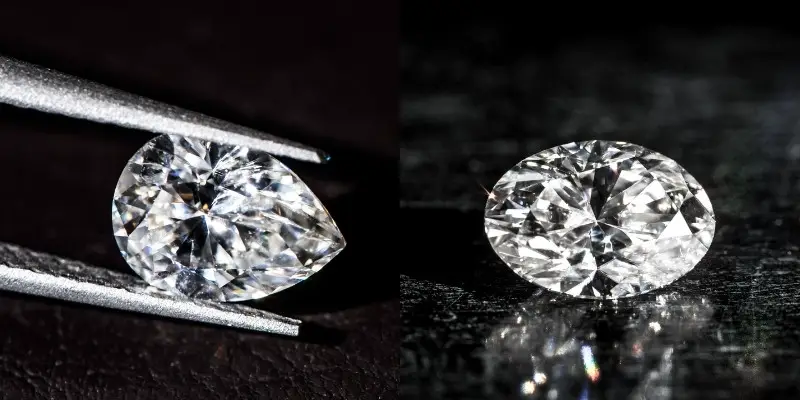
The bowtie resembles a figure 8 with the thinnest point right on the diamond’s culet. The two ‘wings’ do not receive and reflect as much light, which means there will be a dull area on the diamond.
This is just the way ovals, pears, and marquise diamonds work because they have more facets, and smaller ones near their ends, and larger, wider ones near the middle (where the bowtie is visible). Some like the bowtie, some don’t. In either case, you should know that there is no avoiding it, just choosing a diamond with a less noticeable one.
Be mindful of the length/width ratio for pear and oval cuts
The length to width ratio for ovals and pears is actually very important because they are not all made the same. With pears you also take into account the angle for the point as well.
The most flattering shape for a pear cut is considered to be a 1.30:1 ratio with a well rounded bottom and just slightly curved edges leading into the point. Some prefer really skinny pears with straight edges leading into the point. Others like a plump pear with a very rounded top. Just remember that when it comes to pears (and marquises) the perfect shape and ratio is more of an art form and is a very subjective matter.
As for ovals, the idea is to not get one that could easily be confused for a poorly made round cut. So a ratio of 1.35:1 to 1.50:1 is best for the oval cut. Anything longer than that and it ends up too skinny. But, a skinny oval does leave room for side stones if you like.
All in all, you should now have an idea of what to expect when going to get an oval or pear cut. We hope you’ll have a great time trying on the different diamonds for your engagement ring !

I’m the main author for jewelrymaterialguide.com. I started this site after we did tons of research before our wedding and noticed that there is information about rings, jewelry, and so on that is really hard to find on the internet.

